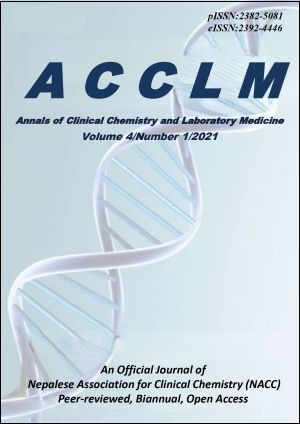Prevalence of pathogenic bacteria in meat products and their antimicrobial resistance pattern
DOI:
https://doi.org/10.3126/acclm.v4i1.42676Keywords:
Antibiotic resistance, antibiotics, MDR, MeatAbstract
Background: There is increase in consumption of antimicrobial agents with misuse and/or overuse of antimicrobial agents in animals and resulting to rise in antimicrobial resistance. The controlled use of antimicrobials is important for national and international policymakers to draw guidelines on its use. Assessing AMR in meat-producing industry is essential to track emerging resistant pathogens that are common between animals and humans. In this study, we have aimed to investigate the prevalence of bacteria in meat products and the antimicrobial resistance pattern in those isolates.
Methods: This study is a quantitative, observational study, where we collected meat samples (n=118) from shops, in Banepa and Dhulikhel Municipality. The samples were cultured in appropriate media for isolation of bacteria. Subsequently, AMR pattern was studied through antibiotic susceptibility test using Kirby Bauer Disc Diffusion method.
Results: In our study, only two sites, out of 48, did not have any pathogenic bacteria. There were total of 113 iso-lates from 118 samples. E. coli (62.8%), Enterococcus (14.1%), Klebsiella pneumoniae (11.5%), were the most prevalent bacteria in processed samples including MRSA (4%). Additionally, 81.6% of the isolated E. coli were resistant to Ampicillin and 60.5% to Ciprofloxacin and 35% to Gentamycin. 43.6% of all isolated E. coli, 100% of all Klebsiella, 100% of all Enterobacter and 25% of all Citrobacter were multi-drug resistant. The resistance was mostly observed against Ampicillin (83.3%), followed by resistance against Ciprofloxacin (64.4%), Gentamycin (58.8%), Ceftazidime (38.8%), with the lowest resistance against Sulbactam/Cefoperazone (3.3%).
Conclusion: E. coli was the most prevalent organism in meat samples. Multi-drug resistance was also most common in E. coli with resistance against Ampicillin, Ciprofloxacin and Gentamycin. Therefore, we recommend for more controlled use of antibiotics in animal rearing industry and more hygienic environment at meat vendors.
Downloads
Downloads
Published
How to Cite
Issue
Section
License
Copyright (c) 2021 Nepalese Association for Clinical Chemistry

This work is licensed under a Creative Commons Attribution-ShareAlike 4.0 International License.
Authors who publish with this journal agree to the following terms:
- The author transfers copyright to the Nepalese Association for Clinical Chemistry.
- The journal publishes the work under a Creative Commons Attribution License that allows others to share the work with an acknowledgement of the work's authorship and initial publication in this journal and under the same share-alike license used here.
- Authors are able to enter into separate, additional contractual arrangements for the non-exclusive distribution of the journal's published version of the work (e.g., post it to an institutional repository or publish it in a book), with an acknowledgement of its initial publication in this journal.
- Authors are permitted and encouraged to post their work online (e.g., in institutional repositories or on their website) prior to and during the submission process, as it can lead to productive exchanges, as well as earlier and greater citation of published work (See The Effect of Open Access).




